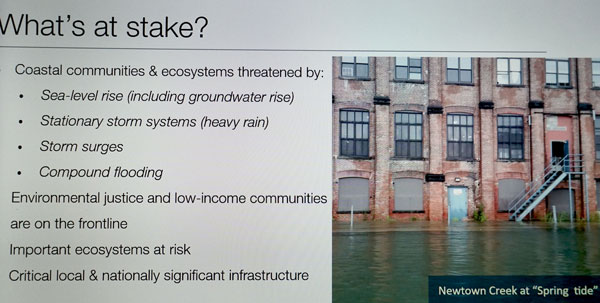A $52 billion storm surge protection project proposed for New York City that includes a series of flood gates in the New York Harbor needs an overhaul to address a broad spectrum of flooding sources that could inundate the city and surrounding environs.
Critics say the proposal by the U.S. Army Corps of Engineers (USACE) primarily focuses on flood surge from major storms such as Hurricane Sandy. The plan needs also to account for the impact of issues such as heavy rain, higher sea level rise and compound flooding.
“This is a much more complicated problem,” says Tracy Brown, president and Hudson Riverkeeper, a group whose mandate is to protect and restore the Hudson River and its tributaries in New York City from their source to the Atlantic Ocean.
Brown likens the USACE’s “very narrow mandate…to trying to fit a square peg into a round or lumpy flabber-shaped hole. There is so much complexity in what we have to address in the region here related to our flooding.”
Brown and others presented a case for the Corps to rethink its proposal at a webinar hosted by Riverkeeper recently in New York.
The USACE’s tentative plan called Alternative 3B was selected over five options.
It consists of a combination of barriers, floodwalls, levees, pumps, nonstructural measures and natural features.
A public comment period on the proposal is being conducted until March 7.
Brown told the webinar audience the Corps should focus first on nature-based infrastructure, followed incrementally by gray infrastructure.
While lobby efforts were successful in making legislative change that requires the Corps to broaden its study perspective beyond just storm surge, the changes have not been reflected in the current plan, she points out.
The Corps’ proposal calls for 12 storm surge barriers across the mouths of waterways including Jamaica Bay and Flushing Creek where they flow into the New York Harbor.

Brown says one of the criticisms Riverkeeper and its partners have of the proposal is that even when the gates are open tidal flow could be choked off, stopping fish migration and trapping contaminants.
Riverkeeper opposes storm surge gates also “because they don’t actually protect against sea level rise or heavy rain. It’s a huge downside for our quality of life.”
While shoreline walls and raised promenades can be effective in parts of the city such as Lower Manhattan, there are opportunities along many waterways and coastal habitats in the city’s greater area for berms and measures to keep rivers flowing, she says.
According to the Corps study, about 60 per cent of the residents on the front lines of storm surge flooding dwell in low-income communities.
“We also have a lot of important eco-systems at risk,” adds Brown.
The new cost benefit analysis underway needs to include environmental and social impacts, Brown points out.
Milestones for the USACE project include the completion of a feasibility report on the tentatively selected plan in a year. If the report is approved by congress then funding will be appropriated.
The pre-construction and engineering phase could take five to six years, followed by a 14-year construction schedule ending in 2040, says Brown.
The USACE study on flood protection was spurred by the catastrophic damage caused by Hurricane Sandy in 2012. Along with the Corps, partners and co-sponsors on the project include New York and New Jersey state departments and the city of New York.
Sixty-five per cent of the project’s cost will be funded by the federal government with most of the remainder financed by state and municipal governments. Ongoing operations and maintenance will be financed by local sponsors and partners.
The webinar included comments by such other organizations as the Newtown Creek Alliance, the New York-New Jersey Baykeeper and the Gowanus Canal Conservancy.
Input on the changes to Biscayne Bay, Miami, resulting from years of neglect were discussed by a representative of the Miami Waterkeeper.
New York City has 520 miles of waterfront, more than Miami, Los Angeles, Boston and San Francisco combined. For more information, visit riverkeeper.org/barriers.











Recent Comments
comments for this post are closed